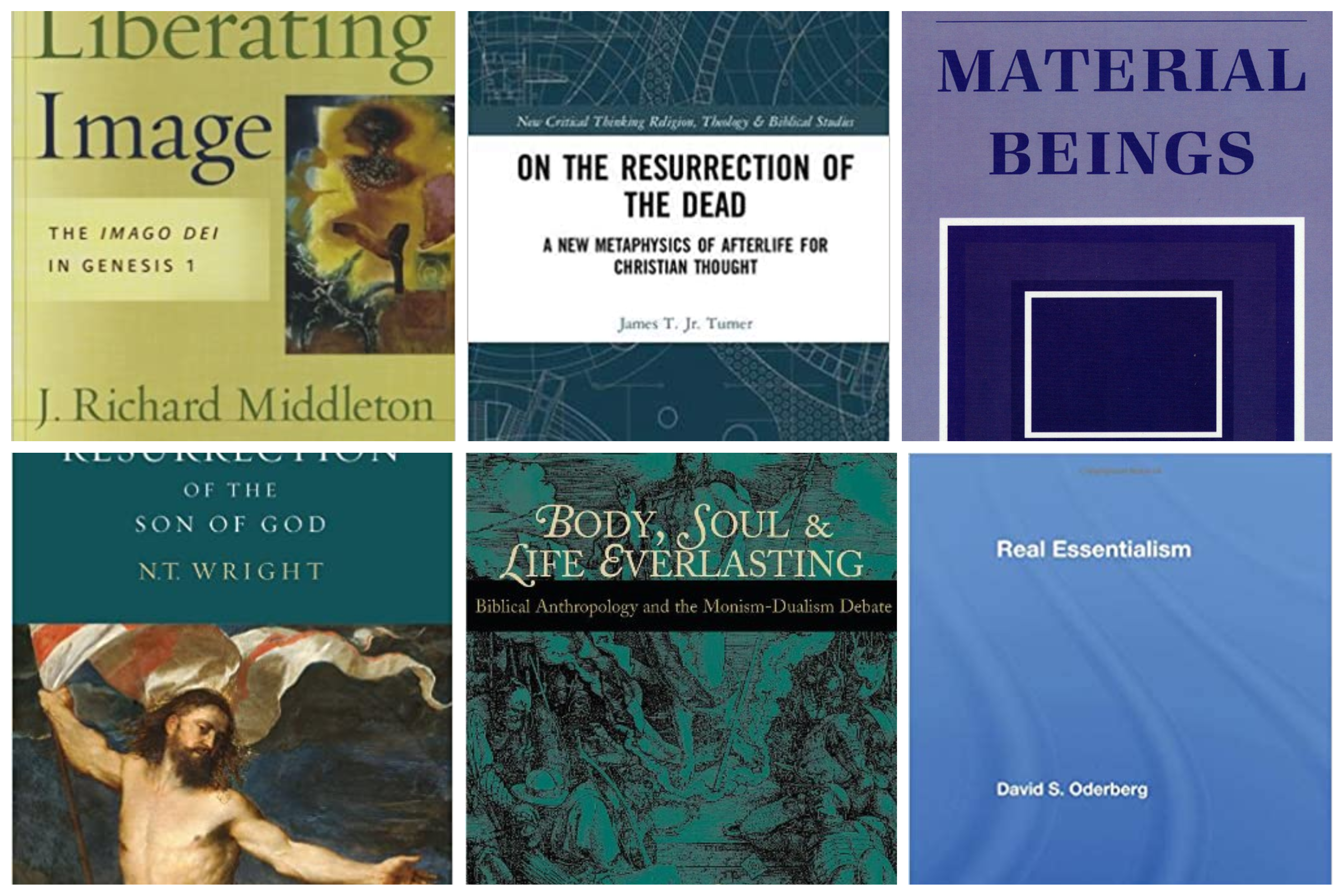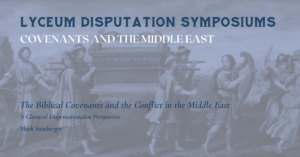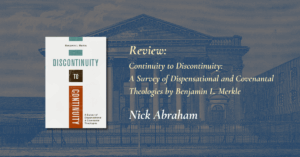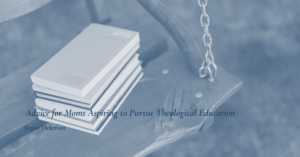A few months ago, Jordan Steffaniak reached out to me asking if I’d provide a short write-up covering three to five books about the doctrine of the resurrection and/or theological anthropology that I think are important. “Sure!” I said, thinking this would be an easy task. Now, having sat down to write it, I’ve found the task isn’t so simple. At least, it isn’t simple for me. And that’s in part because there are so many great resources out there. The last fifteen to twenty years have seen a surge in research related to these areas. Because of this, keeping my list to five turns out to be a tough assignment. If you’ve seen the title of this write-up, you’ll know already that I failed. Additionally, given this introduction, an obvious caveat is in order: what I say below is but a dipping of the toe into the ocean of great resources. If you’re interested in this research topic, what I can say is best quoted from Obi-Wan Kenobi’s words to Rey (“Skywalker”) in Episode VII: “These are your first steps.”
Here’s a second caveat, one that should go without saying, but, given that the arena into which this will be published is available to a general/popular audience, I need to make it plain. Most of my assessments of these texts are open to critique. What I say here neither implies nor entails that everyone in the guild thinks this way about these texts. So, feel free to disagree. I offer here a summary of some thoughts on these texts as someone who’s published in this area and has been, for more than a decade now, researching the topic.
Final caveat: though I think that ancient, medieval, and modern philosophical and theological works on this subject are important (e.g., Aristotle, Augustine, Scotus, Locke, Hume), I only include one such source in the list. That’s not because I think the sources in this list are better all things considered; it’s just that I think they’re better sources with which to begin. For those just beginning their research into the topic, my own advice is to let the more contemporary works lead you backward.
What I have below is a list of books that includes (mostly contemporary) analytic philosophy, biblical studies/ancient history, and systematic theology. Moreover, I’ve included books on philosophical anthropology (or: the metaphysics of human beings), theological anthropology, theological examinations of the resurrection, and philosophical examinations of the resurrection. The reason I have included all of these methodological approaches and their various kinds of literature is that I think that well-rounded research into human beings and human resurrection requires that one thinks through, as well as one can, all the relevant questions, be they biblical, historical, theological, or philosophical. Leaving any of them out, to my mind, leaves a particular research program impoverished. Often that’s on purpose; one always is forced to delimit the scope of one’s research. Even still, I think that theological/philosophical anthropology cannot proceed well without thinking about it in terms of resurrection. The two ideas are mutually informative. This is true, in part, because resurrection tells us something about the purpose of the human being. And, in good Aristotelean fashion, I think that explaining a thing without understanding its purpose is a fool’s errand. The texts to which I refer below, then—when combined—touch on all of these issues.
With that out of the way, here’s my list (sorted by kind).
Biblical Studies and Christian Origins
N.T. Wright, The Resurrection of the Son of God (Minneapolis, MN: Fortress Press, 2003).
- There’s almost too much for me to say about this monograph. What’s important: if one’s going to do sustained research into the Christian doctrine of the bodily resurrection, this text must be consulted. It’s a scholarly text; so, it presents an argument. As such, it’s vulnerable to being outpaced and undercut by further research. But, at present, for resurrection research, this is a must-have. In short, here’s why: its historical trace concerning the biblical material and its cultural underpinnings is near total. What Wright does, through the investigation of ancient Hebrew culture and first century Christianity, is provide a case for a particular way of thinking about the doctrine of the resurrection and Christian views concerning afterlife. There are at least two main takeaways: (1) whatever one wants to say about what happens immediately after one dies, one shouldn’t think that this is the final state or anything like it. And that’s because (2) the Christian hope rests entirely on the bodily resurrection of Jesus and the bodily resurrection of his followers. Or, in a phrase I like to use: for the Christian, it’s resurrection or bust!
J. Richard Middleton, The Liberating Image: The Imago Dei in Genesis 1 (Grand Rapids, MI: Brazos Press, 2005).
- The concept of the Imago Dei or “the image of God” is central to Christian thinking about the human being. Understanding what being an image of God is, is historically vexed and complicated; but recent scholarship provides new and interesting light on the topic. The above monograph is one such piece of scholarship and is now my “go to” for those starting to investigate what the Bible means when it communicates (infrequently as it does) about the image of God. Middleton’s is the first text that I read that introduced me to the idea that the term ‘divine image’ or ‘image of God’, in the Ancient Near East, refers particularly to the kinds of activities/functions involved in image bearing. It presents an exegetical and historical case for a—what one might call— “functional” account of the image of God. But Middleton’s examination makes the functional account more specific: image bearing is a royal and priestly function. Importantly, Middleton doesn’t argue that the Hebrew Bible and Christian Bible merely are aping ANE ideas and terms. Rather, he argues that the biblical authors turn the ANE idea on its head. Image bearing is democratized. As it turns out, the living God establishes that every human together is/are the image of the living God—not just the pharaoh or king or priest. This has massive implications for how to think about the worship of God and the Christian life. It also, of course, has massive implications for the nature and task of human beings.
J. Richard Middleton, A New Heaven and a New Earth: Reclaiming Biblical Eschatology (Grand Rapids, MI: Baker Academic, 2014)
- I’m not ashamed to say that I’ve become a bit of a “fan boy” of Middleton’s recent work. With this text, as in The Liberating Image, Middleton helped to make clearer some of my own thoughts concerning the point and purpose of the cosmos and, in particular, how to think about God’s work in New Creation. The goal of the entire creation—and thus the goal of each human being—is not to be thrown away (creation) or to leave creation (humans), but to be transformed into a place and a people for the living God. It’s because of this work that I refer always to our final and everlasting state with the risen Jesus as New Creation, never “Heaven.” It’s this cosmos renewed and redeemed. Those who wish to argue that the Bible teaches neither the renewal nor the consummation of this creation will need to attend to the exegetical evidence presented in this monograph. What does the purpose of the cosmos have to do with human nature? Answer: humans are an integral part of the created order who play a particular and divinely appointed role (see above) in bringing the created order to its (teleological) end. Our eternal destiny and our purpose, then, is wrapped up in the point and purpose of this cosmos. (This isn’t a valid argument I’ve just given; there are several missing premises. If you want to see the argument fleshed out, I have a paper on the topic in Canadian-American Theological Review 8 (1)(2019)).
Theology (Systematic, Analytic, and/or Biblical)
St. Thomas Aquinas, Summa Theologiae QQ.75-102 (and St. Thomas Aquinas’ De Anima)
- If there’s a more note-worthy, readily available, and exhaustive treatise on the nature of human beings than questions 75-102 of Thomas’s Summa, I don’t know of it. Moreover, it has the added benefit of being rigorously argued, Aristotelean in its metaphysics, and steeped in wrestling with the biblical texts and Christian tradition. I don’t think Thomas gets everything correct. For example, I think he’s wrong about the intermediate state (the “place” one goes after one’s bodily death and before one’s bodily resurrection), I think he’s wrong about how knowledge works, and so on. But he’s thought deeply about nearly every thoughtful question on the subject, both philosophically and theologically. Moreover, he’s a thinker the genius of which has resounded through the Church’s thinking and “secular” philosophy for 800 years. That alone is a pretty good reason to take seriously his work.
John W. Cooper, Body, Soul, and Life Everlasting (Grand Rapids, MI: Eerdmans, 2000).
- Cooper’s text is aging now a bit, I admit. But I have it here for at least two reasons. First, its methodology is, when I first was researching the topic early in graduate school, the sort I craved. He attempts to think through the Christian teachings on life after death biblically, theologically, and philosophically. He’s doing the sort of cross-disciplinary investigation that the greats in Church history have done (just see above what I say about Aquinas). And Cooper’s text is all the better for it. In evangelical circles, this has come to be something like “the” defense of the doctrine of the intermediate state. For anyone interested in the question, “what do Protestant Christians think happens after a person dies?”, this is the monograph with which to begin (after, you know, having looked at the various Protestant confessions).
James T. Turner, Jr. On the Resurrection of the Dead: A New Metaphysics of Afterlife for Christian Thought (London: Routledge, 2019).
- Yes, I’ve included my own text. Probably it’s a faux pax to do so. In any case, while I wish someone more intelligent had written it, I wrote it for a reason and I include it for that reason. The doctrine of the intermediate state—that which the Cooper text above defends—has, to my mind, insuperable problems. One is that it’s just wrong about the nature of human beings. I highlight these problems in this book and then offer a theory of afterlife that puts some metaphysics underneath the sorts of insights one gleans from the works of Wright, Middleton, et. al. concerning the importance and purpose of the bodily resurrection. If it helps, my wife likes it (I mean, she’s not read it or anything. But, you know, she’s got really good intuition…J)
Joshua R. Farris, An Introduction to Theological Anthropology (Grand Rapids, MI: Baker Academic, 2020).
- There’s a bit of chronological snobbery here, given that Farris’s text is so new. But he really is the leading voice in evangelical circles on theological anthropology. This particular text is accessible and thorough, making use of the best up-to-date research that we have in the guild. For general questions on Christian views about the human being, Farris’s book is an excellent place to start one’s research (it also helps that it’s affordable). His examinations help open the door to all sorts of research questions and sources.
Philosophy
Peter van Inwagen, Material Beings (Ithaca, NY: Cornell University Press, 1990)
- Van Inwagen is what we might call “a materialist” or a “physicalist.” He denies that humans have souls. Many Christians might be puzzled, then, why I’ve included this. There are many reasons for including this text and many more reasons why this text is a classic in contemporary metaphysics. But, the main reason I have it included in this list is that, when thinking through the resurrection of human organisms, one needs to have some sense of what makes an organism—a single object made up of other objects—the thing that it is. In contemporary metaphysics, this text has become something of a starting place for thinking through the composition of material beings, and human beings in particular. When does a collection of objects become, itself, an object? What are the necessary and sufficient conditions for an object to retain its identity through time? These are questions the answers to which will sit underneath any attempt to explain the metaphysics of bodily resurrection.
Kevin Corcoran, ed., Soul, Body, and Survival (Ithaca, NY: Cornell University Press, 2001).
- The list of contributors for this volume is a sort of “who’s who” in philosophy of mind/philosophical anthropology research from the early 2000s. This is particularly so for those metaphysicians who, at the time, were thinking through the existence of the soul and the nature of life after death. Simply put, there are papers in this volume (nearly all of them) that are must reads for anyone interested in thinking philosophically about the nature of human beings and post-mortem survival. If a methodologically philosophical work on the subject failed to interact with these papers, I’d assume the work was poorly researched.
David S. Oderberg, Real Essentialism (New York, NY: Routledge, 2007).
- In the last fourteen years, Oderberg’s book has helped encourage a further renaissance in neo-Thomistic (or neo-Scholastic) metaphysics. (I don’t know if Oderberg would call his view that; but I’m going to.) As evidence, I offer up Edward Feser’s Scholastic Metaphysics: A Contemporary Introduction. In it, he acknowledges that his work is indebted to Oderberg’s (see the book’s acknowledgements page). And if anyone’s been following new works in Thomistic metaphysics and philosophy, one will be familiar with Feser’s work. In any case, I’m convinced that the Aristotelean-inspired Scholastic way of thinking about the human being is correct (barring its views about the ability of the human soul to exist apart from a human body). And this book is my favorite treatment of the metaphysics that fuels my favored Scholastic approach to philosophical anthropology, viz., hylemorphism. Hylemorphism is a comprehensive metaphysics. That is, if it’s true, it’s true of everything, including humans. One can think, then, that this text is an examination and defense of a particular way to think about hylemorphism. My own work depends heavily on Oderberg’s; so, I’d be remiss not to mention it.
Author
-
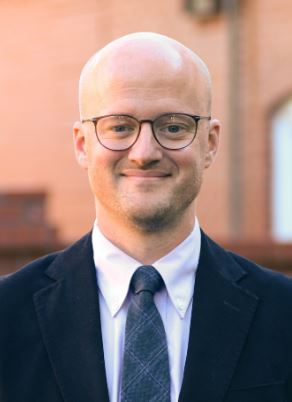
J.T. Turner (PhD, The University of Edinburgh) is Assistant Professor of Philosophy at Anderson University (SC). He specializes in analytic theology, particularly concerning doctrines of the resurrection and afterlife. He has published one monograph in his area of specialty: On the Resurrection of the Dead: A New Metaphysics of Afterlife for Christian Thought with Routledge Press. And he has several papers in print in various academic philosophy and theology journals. More recently, he (with another of the London Lyceum’s fellows, James Arcadi), published the T&T Clark Handbook of Analytic Theology, in which he also contributed a chapter concerning the doctrine of the resurrection.
View all postsRecent Posts
